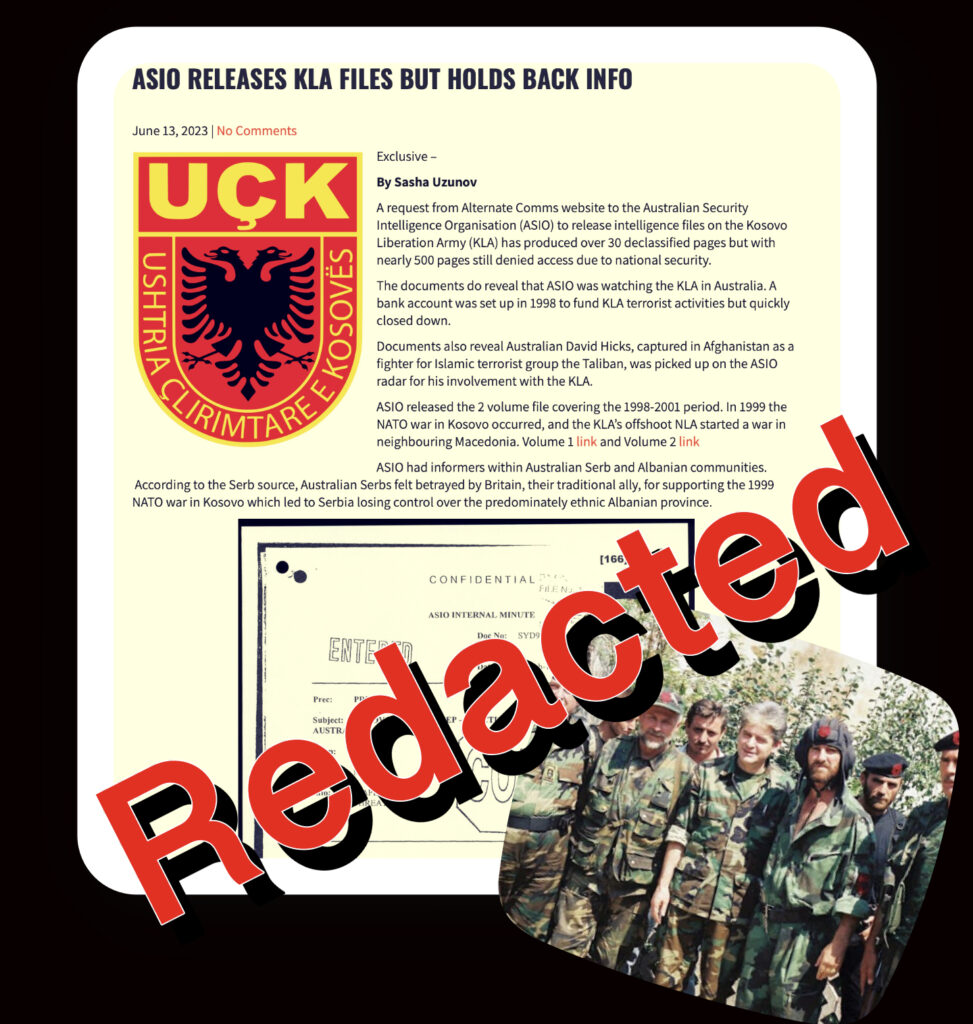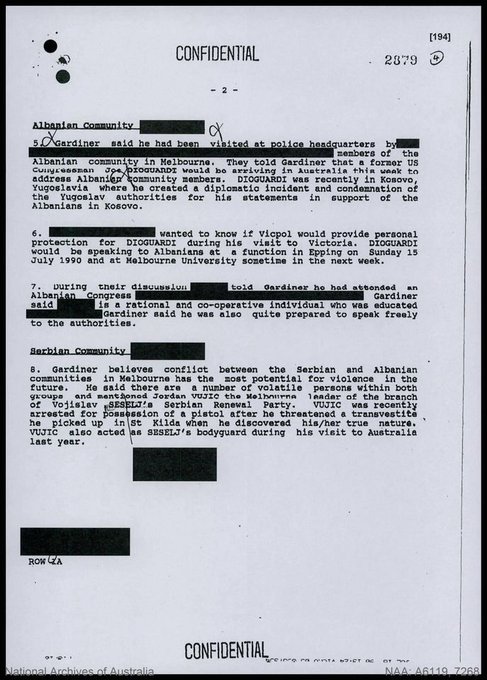
By Sasha Uzunov
I applied to the National Archives of Australia for Australian Security Intelligence Organisation (ASIO) documents on the Kosovo Liberation Army (KLA) for the period 1998-2001. My interest was sparked by the KLA’s involvement in starting a war in Macedonia in 2001.
After a lengthy wait, I was given a two-volume file consisting of about 500 pages, but 470 were redacted-as in removed for security reasons. It immediately raised the question what was so sensitive about the KLA that ASIO did not want to reveal?
In more than a decade I have applied for thousands of pages of ASIO files on subjects relating to the Balkans. Most of the time, I would receive files bulging with information. But not this time.
In 1995 the KLA was formed and began as a terrorist group in the Serb autonomous province of Kosovo-Metohija of what was left of Yugoslavia after its collapse in 1991. Kosovo is about 90% ethnic Albanian.
The KLA’s goal was independence from Serbia or rump Yugoslavia. It resorted to attacking Serb police and government officials claiming it was defending Albanians from Serb persecution.
Yugoslavia was a communist federation formed in 1944 by Marshal Tito. It was made up of six republics, Serbia, Croatia, Slovenia, Macedonia, Montenegro and Bosnia-Hercegovina. After 1974 constitutional changes, two autonomous regions, Kosovo-Metohija and Vojvodina, were created within Serbia. Vojvodina has a sizeable ethnic Hungarian minority
Rising Serbian nationalism exacerbated by Albanian nationalism in Kosovo soon after Marshal Tito’s death in 1981 began to spook the other republics. In Serbia proper, a communist technocrat and banker Slobodan Milosevic began his rise to power by the mid 1980s with countering Albanian nationalism in Kosovo as his rallying cry
By 1991, the northernmost and most western orientated republic Slovenia seceded from Yugoslavia in response to Milosevic. Soon, Croatia, Bosnia and Macedonia would follow. Then followed bloody conflict in Croatia and Bosnia, pitting Serbs against Croats, Serbs against Bosnians, Croats and Bosnians, lasting until the mid 1990s.
The United States branded the KLA in 1998 as a terrorist organisation.
But that narrative was soon to change as the KLA became of strategic importance to the US.
In short, the KLA transformed overnight in the mainstream media from terrorist group with links to organised crime and drug smuggling to freedom fighters, trained by the US and UK for the 1999 NATO war against Serbia.
US expert Professor Samuel P. Huntington in his book The Clash of Civilisations and the remaking of world order”, (1998, page 283) wrote:
[In 1995] An official of US State Department declared: ” a long-term calculation that ultimately, two local powers will dominate this part of the world–one in Zagreb, one in Belgrade; one tied to Washington, the other locked into a Slavic bloc extending to Moscow.”
In 1997 ASIO began monitoring of KLA activities in Australia, especially fund raising, as revealed by the declassified ASIO file.
There is a sizable ethnic Albanian community in Australia from both Kosovo and Macedonia. The vast majority of whom are Sunni Muslims.
In 1999 the US and NATO intervened in Kosovo on the pretext of stopping atrocities committed by the Milosevic regime against ethnic Albanians. But this pretext allowed the US to later establish a large military presence in the Balkans as a bulwark against possible Russian interference in the region.
A bombing campaign of the Serb capital, Belgrade, resulted, in which a number of targets were hit including the Chinese Embassy. The US claimed the hit on the embassy was a mistake.
In an interesting parallel, Russia has used the US/NATO intervention in Kosovo as a justification for its intervention in Ukraine beginning in 2014 and the advent of war in that country waged to protect ethnic Russian minority from Ukrainian nationalists. But pro-Western pundits regard Russia’s intervention in Ukraine with enormous scepticism which doesn’t equally apply to US intervention in Kosovo
Serb nationalists claim the NATO intervention was to separate Kosovo from Serbia and set up a US protectorate in the Balkans region. Albanian nationalists claim that the NATO intervention was justified on humanitarian grounds and was a last resort by the West. Since the removal of Serb rule, Kosovo has become an independent nation-state. But a number of countries still recognise Serb sovereignty over the region. Kosovo’s status remains a boiling issue even now with the possibility of new conflict breaking out.
In 1999 Australia took in a large number of Kosovar refugees temporarily until the NATO war ended before they were returned to Kosovo. Since kicking out the Serbs, the US has built a large military base called Bondsteel in Kosovo.
Able to host more than 7000 troops on site, Camp Bondsteel is currently the largest and widest base run by the United States of America in the Balkans
US President Joe Biden some years ago called KLA leader Hashim Thaci the George Washington of Kosovo!
“TERRORISM”
The ASIO file on the KLA s in marked “Terrorism Foreign Kosovo Liberation Army General.” ASIO’s interest in the KLA was sparked because of money being raised in Australia on its behalf.
There are a few pages in the ASIO file but the rest is redacted. This no doubt creates a mystery. Also, KLA had links to Islamist groups, which set off ASIO’s radar.
Australian Islamic terrorist David Hicks, who was caught fighting for the Taliban in Afghanistan in 2001, is mentioned in the ASIO file but it is very brief. He was linked to the KLA. But, again, many pages have been redacted, removed from the ASIO file.
There is no mention whatsoever in the ASIO file of the KLA’s offshoot, named as the National Liberation Army (NLA), which began a terrorist war in neighbouring Macedonia in 2001 to grab territory to create a Greater Albania and link it up with Kosovo and Albania.
Macedonia was one of the former Yugoslav republics which escaped the war when Yugoslavia collapsed in 1991 and even assisted the US and NATO in its war against Serbia in Kosovo in 1999. So the 2001 war in Macedonia came as a slap in the face to Macedonians who, albeit reluctantly, sided with Washington.
The war was short lived but its consequences were far reaching. In essence, right wing Albanian Neo Nazi extremists, aided and abetted by the US, were imposed upon the Macedonian political scene as a loyal US proxy in Macedonia which supports US foreign policy needs.
At first when the war erupted the NLA was quite rightly condemned by various leaders such as NATO Secretary General Lord Robertson, EU mandarin Javier Solana, US Senator Jesse Helms and others as murderous thugs, terrorists, hell bent on destroying peaceful Macedonia, which had assisted the US and NATO in its war against Serbia in Kosovo.
But when word began to get out the NLA had been trained and equipped by the US, as Guardian reported in 2001, the western media narrative changed.
The NLA was transformed into civil rights activists with grievances.
There is a large Macedonian community in Australia and ethnic Albanians from Macedonia in Australia too. The 2001 war would have been monitored by ASIO for any possible disturbances here in Australia.
One can speculate, wildly, but could the reason for ASIO’s redaction of its large KLA file, two volumes, be because of the KLA’s close links to the US intelligence organisations and by extension Australia’s own security apparatus?
A few years ago I obtained the Australian Intelligence (ASIO) file on ultra Serb nationalist, and later war criminal in the Bosnian conflict, Vojislav Seselj who conducted a controversial visit to Australia in 1989. It is a two volume file with plenty of material not redacted. In Seselj’s file there is a mention of ex US Congressman & Albanian lobbyist Joe Dioguardi planning to visit Australia in 1990 and a request for local police protection. The odd thing is, a later separate search for an ASIO file on Dioguardi, revealed no ASIO file exists!
